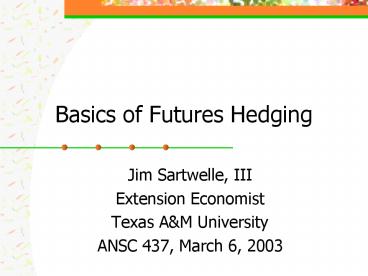Basics of Futures Hedging - PowerPoint PPT Presentation
1 / 19
Title:
Basics of Futures Hedging
Description:
What was Johnny's question? ... Futures and cash prices generally move together. If futures and cash prices decrease while a hedge is in place, gains in the ... – PowerPoint PPT presentation
Number of Views:102
Avg rating:3.0/5.0
Title: Basics of Futures Hedging
1
Basics of Futures Hedging
- Jim Sartwelle, III
- Extension Economist
- Texas AM University
- ANSC 437, March 6, 2003
2
What do you worry about when you own cattle?
- That the price might go down before you can get
them sold - You know your breakeven, but you dont really
know if you can meet it - How can you manage that risk?
- Forward contract
- Hedging with futures
REVIEW OF 10-17
3
What are futures?
- A futures contract is a binding agreement between
a seller and a buyer to make (seller) and to take
(buyer) delivery of the underlying commodity at a
specified future date with agreed upon payment
terms.
REVIEW OF 10-17
4
Contract specifications for cattleEach trades at
the Chicago Mercantile Exchange from 905 am to
100 pm CST
- FEEDER CATTLE
- Months Jan, Mar, Apr, May, Aug, Sep, Oct, Nov
- 50,000 pounds of 700-849 USDA Medium Frame 1
and Medium and Large Frame 1 steers
- FED CATTLE
- Months Feb, Apr, Jun, Aug, Oct, Dec
- 40,000 pounds of 55 Choice/45 Select live
steers
REVIEW OF 10-17
5
Impact of a change in value
- The impact depends if you bought the futures
contract or sold the futures contract - Futures jargon
- Short position means you sold the futures
- Long position means you bought the futures
REVIEW OF 10-17
6
Impact of a change in value, contd
- If you are in a short position (you sold)
- You benefit from a decrease in value
- If you are in a long position (you bought)
- You benefit from an increase in value
- This is not rocket science. Do not become
intimidated by futures.
REVIEW OF 10-17
7
Back to the breakeven example
- Remember that the East Texas rancher has an
estimated breakeven of 0.7521/lb for 710 pound
steers - What was Johnnys question?
- What can that rancher do to get a sales price
above the breakeven price? - Look to the futures to HEDGE in a price
8
Selling Hedge
- Taking a futures market position that is equal
and opposite to the position that will ultimately
be taken in the cash market - Why do you use a selling hedge?
- When a commodity price is acceptable prior to
when the product is sold in the cash market, a
selling hedge can reduce the risk of declining
prices.
9
How does the selling hedge work?
- Futures and cash prices generally move together
- If futures and cash prices decrease while a hedge
is in place, gains in the futures market offset
lower cash prices - If futures and cash prices increase while a hedge
is in place, losses in the futures market offset
higher cash prices
10
What is basis?
- Simply put, it is cash price minus futures price
- What is it?
- Since futures price is a national price and cash
price is basically local, the difference between
the two is due to local supply and demand factors - Basis is important because it can really screw up
your hedge if youre wrong
11
Steps in implementing a hedge
- Determine your breakeven
- Determine the quantity to hedge
- Use the proper futures contract and contract
month - Estimate your expected basis
- Be disciplined
- Maintain the hedge till you sell in the cash
12
Example Selling hedge for corn
- Bill is a corn farmer who harvests in October.
His 10-year average corn production is 24,000 bu.
During the past 5 years, his lowest production
was 15,000 bu. - At planting in March, Bills expected breakeven
is 2.35/bu - He looks at the futures for a hedge opportunity
13
Selling hedge for corn March
- In March
- December CBOT Corn futures is 2.65/bu
- Historical harvesttime basis is -0.05/bu
- Bill expects a harvesttime cash price of 2.60/bu
(futures price less expected basis) - He decides to hedge 15,000 bu (3 contracts at
5,000 bu each)
14
Selling hedge for corn October
- At harvest
- Cash market at harvest is 2.40/bu
- December CBOT Corn futures is 2.45/bu
- Actual basis is -0.05/bu, as predicted
15
Summary of corn selling hedge
16
How and why did it work?
- How?
- Because the futures and cash prices each went
down, gains in the futures offset the diminished
cash price - Why?
- Bill forecast basis accurately. Basis moves can
increase or decrease the net sales price.
17
Lets go to the paper exercise
18
So what do we have?
- We have a seamless link between production
efficiency, cost of production, market outlook,
and marketing strategies. - YOU CANT HAVE ONE WITHOUT HAVING THEM ALL
19
Closing up
- I will provide an Excel spreadsheet with much of
the historical market information we discussed
last Tuesday - E-mail me at j-sartwelle_at_tamu.edu
- Put Market Spreadsheet in subject line
- Best of luckits been fun































